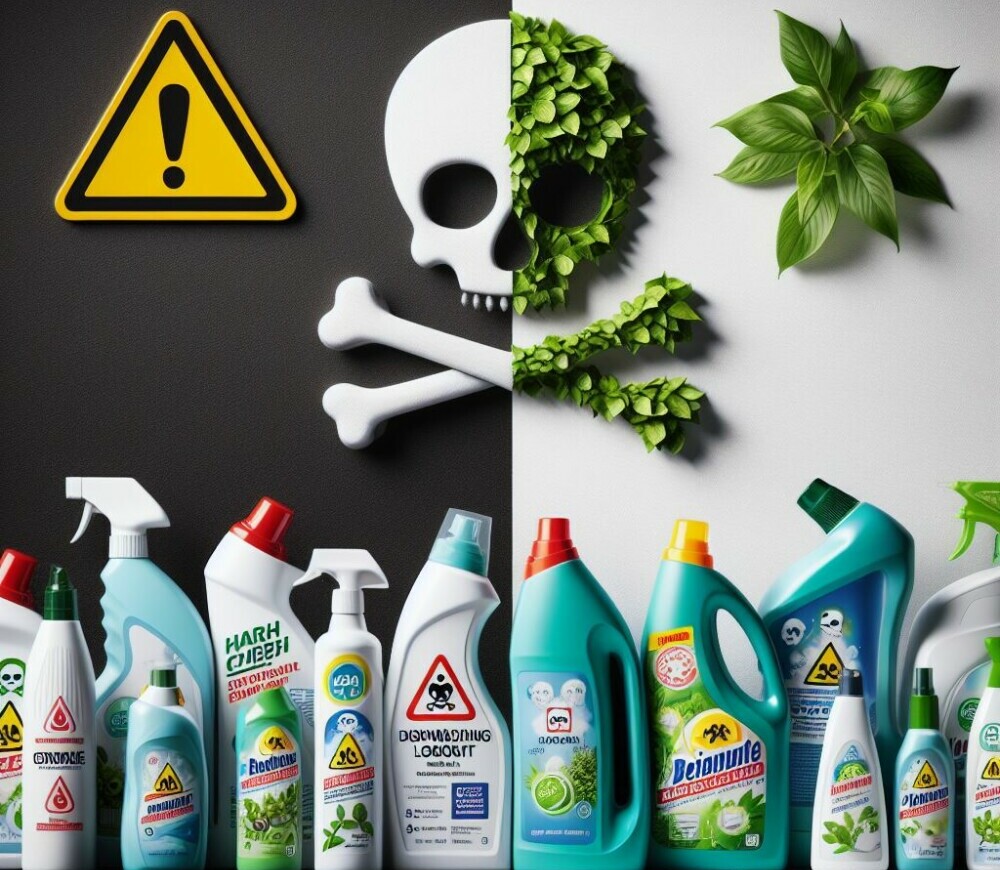
In our fast-paced lives, it’s easy to overlook the potential hazards lurking in our homes and environments. Many common household products and everyday items release harmful chemicals that can affect our health in the long run. Today, we’ll explore the importance of lowering chemical exposure and provide practical tips for creating a healthier living space for you and your loved ones.
I started my journey of eliminating toxins from our home in 2018. We can lower our exposure to toxins in our homes, and bodies and I will help you understand the benefits of limiting our chemical exposure. This isn’t just about industrial waste or pollution, it includes everyday interactions with substances around us. We have options to lessen our contact with everyday toxins in our homes especially, but our environment as well.
Some diseases worsen or are triggered by harmful substances. Smog, for example, can exacerbate asthma; mesothelioma is linked to asbestos, and lead exposure can result in learning disabilities. It’s crucial to learn about these connections to safeguard our health.
Factors Influencing Health Outcomes from Chemical Exposure
When we talk about the impact of toxic chemicals, it’s not a one-size-fits-all situation. A range of factors determines whether and how these chemicals affect your health. Here’s how to understand the varying responses our bodies can have.
First and foremost, the amount of the chemical you’re exposed to, known as the dose, plays a significant role. It’s not just about coming into contact with a chemical; it’s the quantity and concentration that can turn an exposure into a hazard. Larger amounts can overwhelm your system’s defenses, leading to adverse health effects.
Equally important is the duration of exposure: a fleeting encounter may not have the same health implications as a long-term relationship with a harmful substance. Chronic exposures, especially to smaller doses, can accumulate over time, tipping the balance from harmless to harmful.
As we examine exposure frequency, or how often you come into contact with a particular chemical, we see that repeated exposures can also be problematic. It’s the idea of ‘the dose makes the poison’, but also, ‘the frequency can forge the fetter.’
Now, let’s consider individual sensitivity. People are unique, and so are their reactions to chemical exposures. Genetic makeup, age, health history, and even lifestyle choices can make some of us more susceptible to the harmful effects of chemicals than others.
The type of chemical is yet another critical factor. Not all villains in the chemical world are created equal; some have a reputation that precedes them. Mercury and lead, for example, are notorious for their long-term health implications, even at low exposure levels.
Finally, how chemicals enter your body matters tremendously. Inhalation, ingestion, or dermal absorption—each route of exposure can lead to different types of health risks. Some chemicals are more dangerous when breathed in while others pose a greater risk when they come in contact with skin or are eaten.
Understanding these factors is paramount in developing protective strategies against harmful chemical exposure. By staying informed, you can better manage potential risks and support your well-being.
Strategies for Minimizing Exposure to Harmful Chemicals

I will guide you through some practical ways to reduce your run-ins with harmful chemicals. Now, this is crucial because your well-being hinges on how well you can evade these invisible hazards.
You can start by getting smart about the places you frequent. Be aware of any known contamination or pollution hot spots you might encounter around your home or workplace. It’s like mapping out the hidden enemies in your everyday environment.
Next up is chemical safety. Something as simple as washing your hands can be a game-changer. Switching cleaning products with a high level of chemicals to cleaner options is advisable, and Doterra Abode Line is amazing!! And don’t forget about those fruits and veggies; give them a good wash to strip away pesky residues.
Labels are there for a reason. They’re your mini guidebooks on the battlefield of chemical exposure. When a product sports a warning, take it as a stop sign.
Options are available to choose skincare and cosmetic items that are free from harmful chemicals. Doterra, for instance, has cleaner options for everyday items like skincare, deodorant, and toothpaste.
Here’s another tip: if you handle treated wood, only one rule applies—don’t burn it. The chemicals used to preserve wood can be pretty harmful once they’re airborne.
Keep your living space airy—good ventilation can be like a breath of fresh air for you indoors. It helps to dilute any chemical vapors lurking around. Explore the role of indoor plants in purifying air and reducing the concentration of indoor pollutants. Additionally, diffusing essential oils can assist in cleansing the air you breathe.
What about disposal? Electronics, batteries, paints—they all have to go at some point. But don’t just toss them into the trash. Following proper disposal guidelines is a key move to minimize harmful exposure.
I’m not just talking about what you’re breathing or touching. Watch what you’re eating, too. Don’t forget about those fruits and veggies; give them a good wash to strip away pesky residues. Also, avoid being the fish that bites the bait; limit your intake of fish high in mercury. Sure, fish is a healthy choice, but picking low-mercury fish is even smarter.
Lastly, that puff of smoke from a cigarette? It’s a chemical cocktail you don’t want to mix with. Avoiding secondhand smoke can significantly cut down your chemical intake.
Implementing Health-Protective Behaviors in Daily Life
I’m going to wrap up our chat about the impact of toxic chemicals on your well-being with some practical steps you can take every day. This isn’t just about avoiding harm; it’s also about embracing a lifestyle that prioritizes your health.
- Eco-Friendly Home Decor: Look for furniture and decor items made from sustainable, non-toxic materials. There are potential hazards associated with certain paints, varnishes, and finishes, so choose alternatives that are safer for both the environment and human health.
- Reducing Plastic Use: Harmful chemicals are found in plastics and they can have a potential impact on health. It’s best to reduce plastic use in daily life, by using glass or stainless steel containers and choosing products with minimal or eco-friendly packaging.
- Educating Children on Chemical Safety: Recognize the vulnerability of children to chemical exposure and guide them on how to create a safe environment. Choose non-toxic toys, furniture, and clothing, and also teach children about the importance of proper hygiene and handwashing.
- Community Engagement: Get involved in local initiatives promoting a reduced chemical footprint. Support local businesses that support raising awareness in your community, and supporting businesses that prioritize environmentally-friendly practices.
In conclusion, taking steps to lower chemical exposure in our homes and environments is a crucial investment in our long-term well-being. By making informed choices and adopting healthier habits, we can create spaces that promote not only our health but also the sustainability of our planet. I hope you feel empowered to take control of your environment and, consequently, your health. Let’s strive for a cleaner, safer, and more environmentally conscious future.
My website contains affiliate links {in this case a referral link}. This means if you click and make a purchase, I may receive a small commission. Don’t worry, there’s no extra cost to you. It’s a simple way you can support our mission to bring you quality content.
DDH
